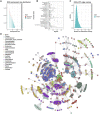BioNAR: an integrated biological network analysis package in bioconductor
- PMID: 37860105
- PMCID: PMC10582516
- DOI: 10.1093/bioadv/vbad137
BioNAR: an integrated biological network analysis package in bioconductor
Abstract
Motivation: Biological function in protein complexes emerges from more than just the sum of their parts: molecules interact in a range of different sub-complexes and transfer signals/information around internal pathways. Modern proteomic techniques are excellent at producing a parts-list for such complexes, but more detailed analysis demands a network approach linking the molecules together and analysing the emergent architectural properties. Methods developed for the analysis of networks in social sciences have proven very useful for splitting biological networks into communities leading to the discovery of sub-complexes enriched with molecules associated with specific diseases or molecular functions that are not apparent from the constituent components alone.
Results: Here, we present the Bioconductor package BioNAR, which supports step-by-step analysis of biological/biomedical networks with the aim of quantifying and ranking each of the network's vertices based on network topology and clustering. Examples demonstrate that while BioNAR is not restricted to proteomic networks, it can predict a protein's impact within multiple complexes, and enables estimation of the co-occurrence of metadata, i.e. diseases and functions across the network, identifying the clusters whose components are likely to share common function and mechanisms.
Availability and implementation: The package is available from Bioconductor release 3.17: https://bioconductor.org/packages/release/bioc/html/BioNAR.html.
© The Author(s) 2023. Published by Oxford University Press.
Conflict of interest statement
None declared.
Figures




Similar articles
-
Computational Pipeline for Analysis of Biomedical Networks with BioNAR.Curr Protoc. 2023 Dec;3(12):e940. doi: 10.1002/cpz1.940. Curr Protoc. 2023. PMID: 38050642
-
GWENA: gene co-expression networks analysis and extended modules characterization in a single Bioconductor package.BMC Bioinformatics. 2021 May 25;22(1):267. doi: 10.1186/s12859-021-04179-4. BMC Bioinformatics. 2021. PMID: 34034647 Free PMC article.
-
PrInCE: an R/Bioconductor package for protein-protein interaction network inference from co-fractionation mass spectrometry data.Bioinformatics. 2021 Sep 9;37(17):2775-2777. doi: 10.1093/bioinformatics/btab022. Bioinformatics. 2021. PMID: 33471077
-
MoleculeExperiment enables consistent infrastructure for molecule-resolved spatial omics data in bioconductor.Bioinformatics. 2023 Sep 2;39(9):btad550. doi: 10.1093/bioinformatics/btad550. Bioinformatics. 2023. PMID: 37698995 Free PMC article.
-
BiocPkgTools: Toolkit for mining the Bioconductor package ecosystem.F1000Res. 2019 May 29;8:752. doi: 10.12688/f1000research.19410.1. eCollection 2019. F1000Res. 2019. PMID: 31249680 Free PMC article.
References
-
- Barabási AL, Albert R.. Emergence of scaling in random networks. Science 1999;286:509–12. - PubMed
-
- Blondel VD, Guillaume J-L, Lambiotte R. et al. Fast unfolding of communities in large networks. J Stat Mech 2008;2008:P10008.
-
- Chua JJE, Kindler S, Boyken J. et al. The architecture of an excitatory synapse. J Cell Sci 2010;123:819–23. - PubMed
-
- Clauset A, Newman ME, Moore C.. Finding community structure in very large networks. Phys Rev E Stat Nonlin Soft Matter Phys 2004;70:066111. - PubMed
LinkOut - more resources
Full Text Sources

